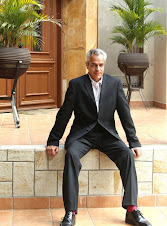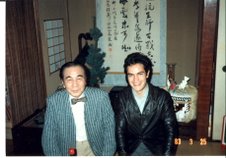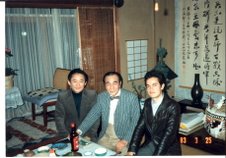Publication of ¡Oh Guitarra!
This autumn saw the publication of my second piece for solo guitar, ¡Oh Guitarra! The publishers are Tre Media of Karlsruhe, the same company that released my first guitar work, Nana del insomne, a few years ago.
A revamped website including this blog and its adjuncts will migrate to a different platform. To ensure continued access please use the domain address, agustinfernandez.com, rather than the individual Blogger addresses. Un sitio renovado incluidos este blog y sus adjuntos migrará a una plataforma distinta. Para asegurar el acceso ininterrumpido se sugiere usar la dirección del dominio, agustinfernandez.com, y no las direcciones individuales de Blogger.
Posted on November 27, 2009
Labels: Christoph Jäggin, Nana del insomne, Oh Guitarra, Tre Media
This is a newly available composition for two pianos. I wrote it over the last year or so, in response to an expression of interest from duoDort in a little piece named Portrait, listed in my catalogue as dating back to 1989, for two pianos, duration three minutes.
Not only did such a miniature seem an embarrassingly small offering to hand anybody, but when I searched for the old manuscript I could not find the final page. After spending hours looking for it I decided it would be easier to rewrite the final page than to search on. How wrong I was. Did I not know, after so many root-and-branch revisions of past efforts, that it is impossible - for me at least - to go back to an old piece without changing it? And change it I did, but to an unsuspected degree.
The experience of trying to transport myself to the old 'me' of 1989 called to mind one of my teenage readings, Herman Hesse's Knulp: Three Tales from the Life of Knulp, known to me in the 1970s by its Spanish title, Tres momentos de una vida. In it Hesse returns to the same character, Knulp, to show us snapshots of three very different periods of his life.
Here I was, in 2008, working hard to replicate the musical logic that must have ruled my thinking twenty years earlier. The experience felt so much like a dialogue between the then and the now that the idea grew in my mind that I could make a virtue of this time dislocation, and frame the little Portrait with something even earlier to come before it and something of the present to follow it.
The idea would have not gone anywhere if I had not remembered that my Cantata de Navidad y Epifanía of 1978, for baritone, children's choir and two pianos, contained an interlude for two pianos. I went back to it and found that it could work, with the necessary adjustments, as a movement in a longer instrumental work. This provided the very early past, Portrait being the distant, but not quite so early past.
For the finale I resorted to my then most recently completed work, the String Quartet No. 1, 'Montes'. For this, remember, is not me looking at myself as I was long ago, then not so long ago and then now, but me looking at the music I composed in these three moments of my life. A form of meta-composition, you might call it.
The finale, then, is a second look at the movement out of the string quartet I find most intriguing, least completed, leaving the most to be said: the third, 'Music and Land'. From a purely compositional angle, I was curious to see how the rhythmic instabilities would work between two players rather than four, and to what extent the sharper definition of the piano's mechanism would enhance the clarity of the rhythmic contradictions and juxtapositions. I am thrilled with the result.
Although I took so long to complete the work, and I came up with fifteen minutes of music when they were only asking for three, it seems that a première by duoDorT is still a possibility. Meanwhile, I have posted up a computer demo version on MySpace and on last.fm.
Posted on September 20, 2009
Labels: Cantata de Navidad y Epifanía, Distant Episodes, duoDorT, Hesse, Knulp, Music and Land, Portrait
Los miembros del Trío Apolo, destinatarios de mi Trío, han emprendido la grabación de esta obra. Ellos la estrenaron en 2003 en el Teatro Achá de Cochabamba, y hace algunos años produjeron una grabación que por razones técnicas acordamos no publicar. El que estos músicos excelentes - Emilio Aliss, Eduardo Rodríguez y Ariana Stambuk - estén ahora realizando una segunda grabación es testimonio de su compromiso profesional infatigable. Les agradezco, les deseo éxito y espero con impaciencia los resultados de este fin de semana de trabajo.
El Trío Apolo encargó mi obra con el apoyo de la Fundación Arnoldo Schwimmer, y desde su estreno en 2003 la ha mantenido en su repertorio a lo largo de sucesivos cambios de personal. Existe en una versión para orquesta de cuerdas y piano, re-titulada Una música escondida, que fue presentada en Newcastle por Northern Sinfonia en 2004 y en La Paz por la Orquesta del Conservatorio Nacional de Música en 2007.
Jaime Martín y su equipo de virtuosos
Posted on March 08, 2009
Labels: Auditorio de Zaragoza, Danza de la loma, Jaime Martín, Orquesta de Cadaqués

The opportunity offered itself to me when one of the postgraduate violinists asked me to write a piece for their masters recital. This felt exactly right: it was a logical next step after Fuego and Peregrine, and it would enable me to work more closely with one of these outstanding young virtuosi. I set out to write a piece that would deploy the virtuosity that clearly was on offer, and I also wanted to challenge and extend the young player’s musicality, stretching their capabilities and generating a tension that, on its release towards the end, would provide a rewarding experience for player and audience alike. And, of course, I wanted to explore a particular idea I had had in mind for some time. I took time to produce the result I aspired to, taking, I think, around a year to complete the work.
When the piece was ready and shipped to New York, the player informed me politely that they would not be able to do justice to it in the time given. Aside from the disappointment this caused me, it meant the consignment of Munirando II to a long period of languishment on my shelves. Over the years I offered it to various players, but always had the same reply: sorry, too difficult. In frustration, I revised it in 2002 to make it more accessible, while still preserving its character of challenging virtuosity. In this revised form, breaking a long-held principle, I submitted the piece to a composer’s competition, the UK and Eire Violin and Piano Competition. Although sceptical of competitions in such a personal field as the creation of music, I harboured the hope that a lucky outcome might finally secure a performance for Munirando II. The piece was shortlisted but not chosen for the prize. Intriguingly, I received a communication to the effect that the chairman of the jury, the late Yfrah Nieman, would be interested in performing the piece if I would find a pianist and a venue. Although vaguely flattering, this seemed a strange idea in the circumstances and I was unsure how to take it. After thinking about it for some time I wrote declining the offer.
It would be another six years before the brave person came up expressing a serious intention to perform Munirando II: the young virtuoso Darragh Morgan, whom I had known in the early 1990s when he was a schoolboy in Belfast and I was composer in residence at Queen’s University. Even in those early days Darragh was showing impressive flair and accomplished technique. He left Belfast for music college and since then I heard about him through third parties, with news of how well he was doing. I sent him the piece and a couple of years later he said he would do it, with his official pianist Mary Dullea. I am delighted, and full of anticipation to hear what Darragh and Mary will do with Munirando II on 5 February at 7.30 PM in the Schott Recital Room, London.
As the title suggests, the piece is part of a series, the first of which was Munirando for clarinet and piano, commissioned by the Park Lane Group in 1995. In both cases the intention is to explore ideas of virtuosity and continuous flow, that maddeningly enviable quality of Bach’s music, taking it into the area of relentlessness.


